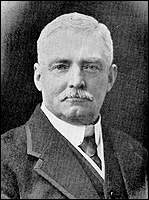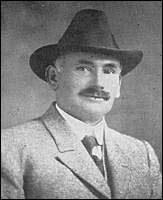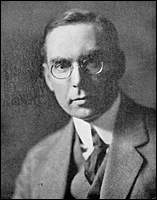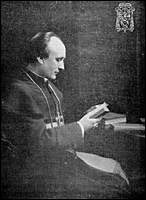|


|

|

The Politics of War
War is a time of great stress when communities either pull together or seem to fall apart.
At the onset of the Great War, Newfoundland society was divided along religious, social
(merchant/fisherman) and geographical (St. John’s/outport) lines. But the war’s outbreak united it in a
common cause.
Sir Edward Morris’ People’s Party was in a weak political position when war erupted. Its
support was concentrated in southern, mainly Roman Catholic districts. In the House of Assembly
it faced the Liberal and (Fishermen’s Protective) Union parties. A coalition government was out of
the question.
In order to bring both parties on side, Morris and Governor Sir Walter Davidson had
crafted the extra-parliamentary, non-denominational Newfoundland Patriotic Association to manage the
war effort. It included key Liberal politicians, among them J. M. Kent and William F. Lloyd. Catholic Archbishop M. F.
Howley, the Church of England’s Bishop Llewellyn Jones and Methodist leaders supported it also.
Its membership included leading business and professional men.
Sir William F. Lloyd.
From Richard Hibbs, ed., Who’s Who in and From Newfoundland 1930, 2nd ed. (St. John’s,
Newfoundland: R. Hibbs, 1930) 55.
 (20 Kb)
(20 Kb)
|
 |

|
William Coaker was leader of the Union Party whose strength lay in northern Protestant
outport districts. Coaker resisted joining the NPA at first. But Morris outmanoeuvred him and his
resistance collapsed. However, Coaker favoured the Royal Naval Reserve over the Newfoundland
Regiment and the alliance was an uneasy one.

|
 |
Sir William Coaker.
From Richard Hibbs, ed., Who’s Who in and From Newfoundland 1930, 2nd ed. (St. John’s,
Newfoundland: R. Hibbs, 1930) 65.
 (18 Kb)
(18 Kb)
|
The war effort was safely in the hands of the NPA, and with young men eager to don uniforms,
it looked as though the Morris government might be able to maintain a united political,
social, geographical and religious front. For nearly three years differences were indeed kept to a
minimum, but in 1917 traditional animosities began to resurface.
Newfoundland’s primary wartime objective was to maintain a steady supply of young men—for
the Newfoundland Regiment, the Royal Naval Reserve and the Forestry Corps. Yet geography and the
structure of the rural fishing economy presented an obstacle to recruitment. Recruiters touring the
island’s south coast in February 1915 were surprised to discover that outport Newfoundlanders did not
necessarily share the enthusiasm for the war effort so evident in St. John’s. In February 1916,
enlistment rates reportedly varied from a high of 1 out of every 36 persons in St. John’s to a low
of 1 out of 329 in Bay de Verde district. In St. John’s it was said that the outports were not
pulling their weight.
The regiment sustained staggering losses in July 1916 and again in October. The number
of new recruits failed to keep pace and it was feared the regiment would cease to exist as a
fighting unit. The mood in St. John’s became even more determined since it was believed that
Newfoundland’s honour was at stake. By January 1917 registration and conscription were being
openly discussed.
Dissatisfaction surrounding the selection of officers, a responsibility of the NPA’s powerful
Standing Committee, was also an issue. It was said that commissions were not being awarded
fairly: St. John’s men were being favoured over outport men, Protestants over Catholics, the sons
of the well-off at the expense of those from the working class. More damaging still, inexperienced
new recruits, ‘sons of somebody,’ were receiving commissions at the expense of experienced men
in the field. Journalist P. T. McGrath, himself a highly visible member of the NPA and a Morris
supporter, aired these and other grievances in the legislature in July 1917.
The perceived failure of the St. John’s commercial establishment to live up to its moral
obligations with respect to trade was another controversial issue. The mainstay of the Newfoundland
economy was shipping, but in 1915 St. John’s merchants began selling off steel vessels at a
substantial profit. Shortages of supplies followed. As consumer prices rose, it was widely held
that merchants used their control over the import, wholesale and retail trades to exact the highest
possible margin of profit. By 1917, there were calls for the government to bring merchants as well
as prices in line. Not for the first time, profiteering merchants were compared to the ‘poor
volunteer.’ In the wake of the highly inflammatory findings of the High Cost of Living
Commission released in June, demands for the conscription of manpower gave way to demands
for the conscription of wealth.
In an effort to rekindle the harmony of the early war years, and facing an uncertain
election in the fall, Morris created a National (coalition) Government in July with a regular
Department of Militia. Responding to calls for the conscription of wealth, the new government
introduced a business profits tax in 1917 and an income tax in 1918. It also created a wartime
Ministry of Shipping and a Food Control Board. Hoping to avoid the conscription of men,
which St. John’s generally supported but the outports opposed, the new government decided on a
renewed voluntary service campaign with the government’s full weight behind it.
Sir John R. Bennett.
From Richard Hibbs, ed., Who’s Who in and From Newfoundland 1930, 2nd ed. (St. John’s,
Newfoundland: R. Hibbs, 1930) 243.
 (15 Kb)
(15 Kb)
|
 |

|
Then suddenly, in December 1917, to the surprise of even his two trusted lieutenants,
Minister of Militia John R. Bennett and Finance Minister Michael Cashin, Morris resigned as
prime minister in favour of W. F. Lloyd, and moved to London (where he soon became Baron
Morris). Several members of the People’s Party, including Richard Squires, abruptly
broke ranks to form the nucleus of an opposition.

|
 |
Sir Richard Squires.
From Richard Hibbs, ed., Who’s Who in and From Newfoundland 1930, 2nd ed. (St. John’s,
Newfoundland: R. Hibbs, 1930) 53.
 (17 Kb)
(17 Kb)
|
From this point, politics dominated the war effort, tied to the conscription issue. The
situation was complicated. Coaker, a key member of the National Government, reluctantly agreed
to join the other parties in supporting conscription, but knew that his outport supporters, who
opposed conscription, would view this as a betrayal.
Moreover, the new Catholic archbishop, Edward Patrick Roche, opposed Coaker, his Fishermen’s Protective Union
and the Union Party. This placed a great strain on the government’s cohesion, particularly because of the behaviour of
Squires and his supporters. Because he had leadership aspirations and wanted Roman Catholic
support, Squires cynically used the conscription issue in an attempt to discredit Coaker with his
followers.
Archbishop Reverend Edward Patrick Roche.
From Richard Hibbs, ed., Who’s Who in and From Newfoundland 1930, 2nd ed. (St. John’s,
Newfoundland: R. Hibbs, 1930) 56.
 (19 Kb)
(19 Kb)
|
 |

|
The conscription crisis ended the relative political harmony which had characterized the first
three years of the war, and seriously weakened the National Government. Once the war in Europe was
over, it was not long before the government collapsed, in May 1919. It was the beginning of a period
of political instability which was not to end until 1934.

|

|
 |